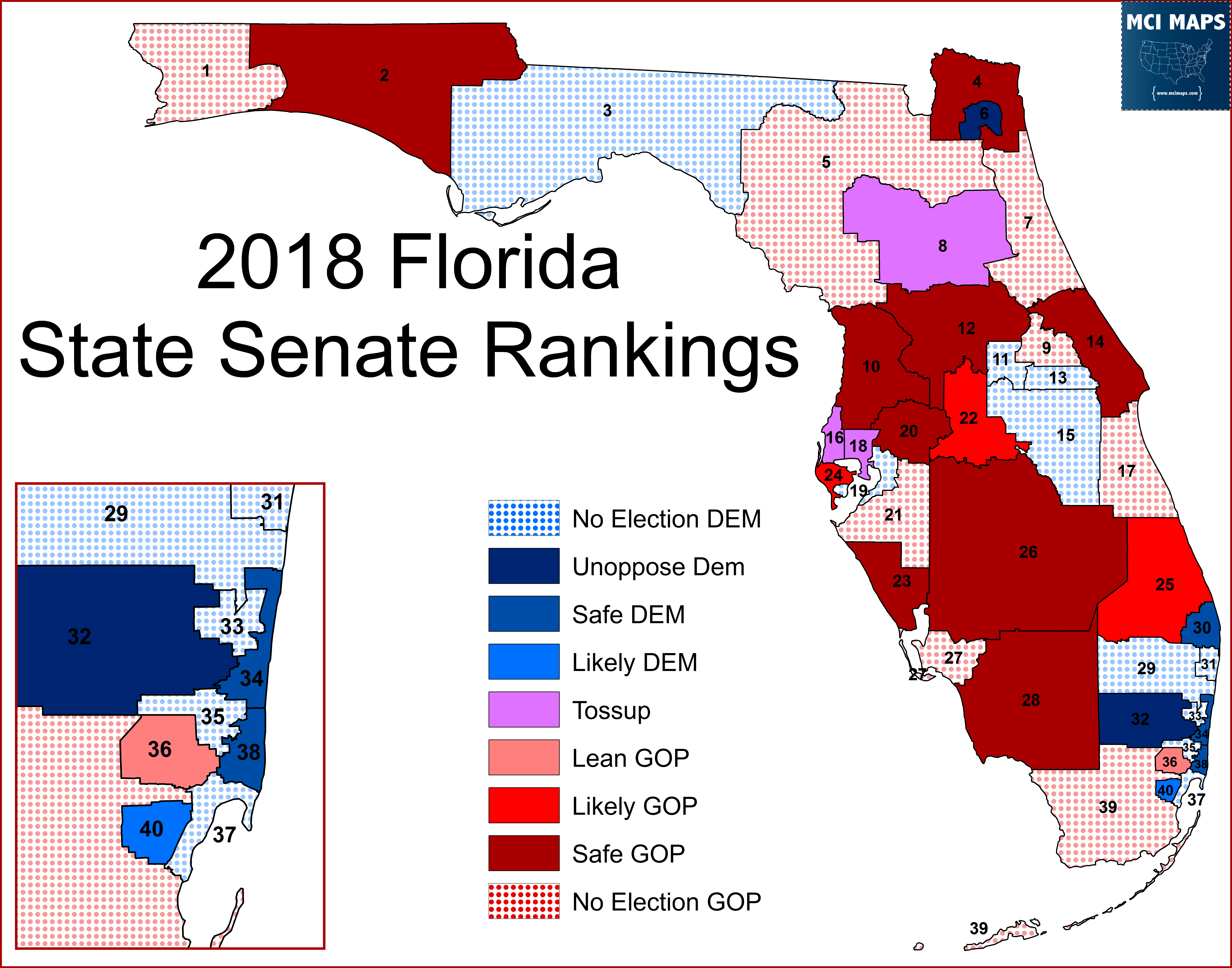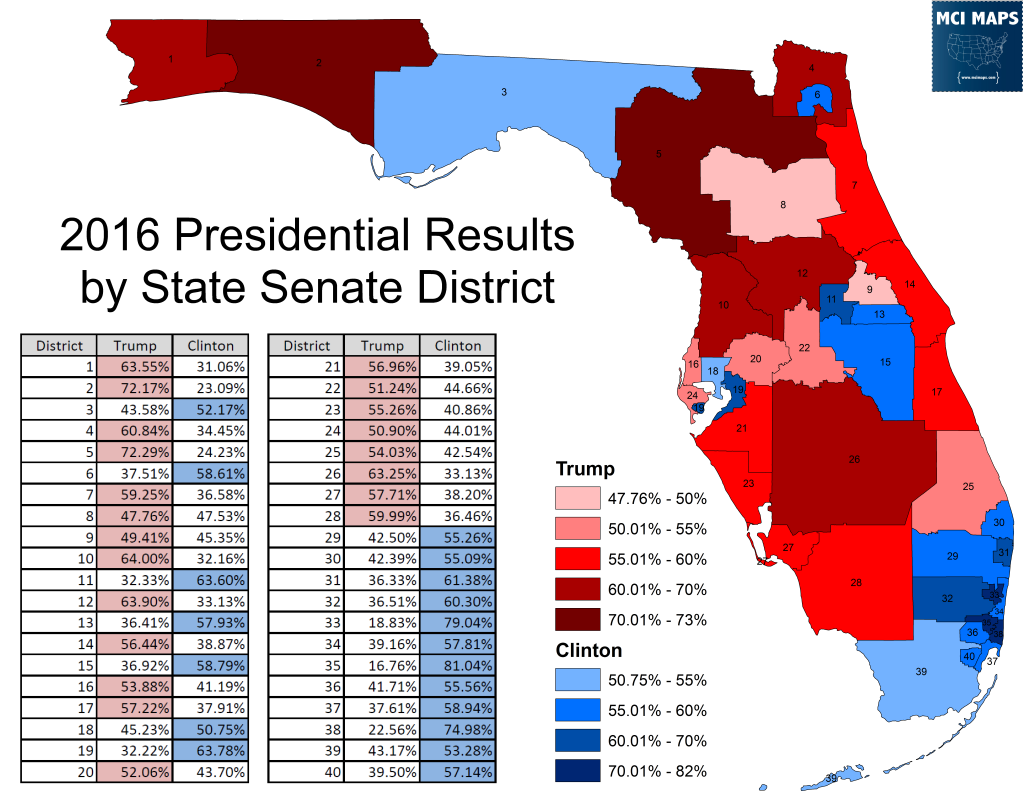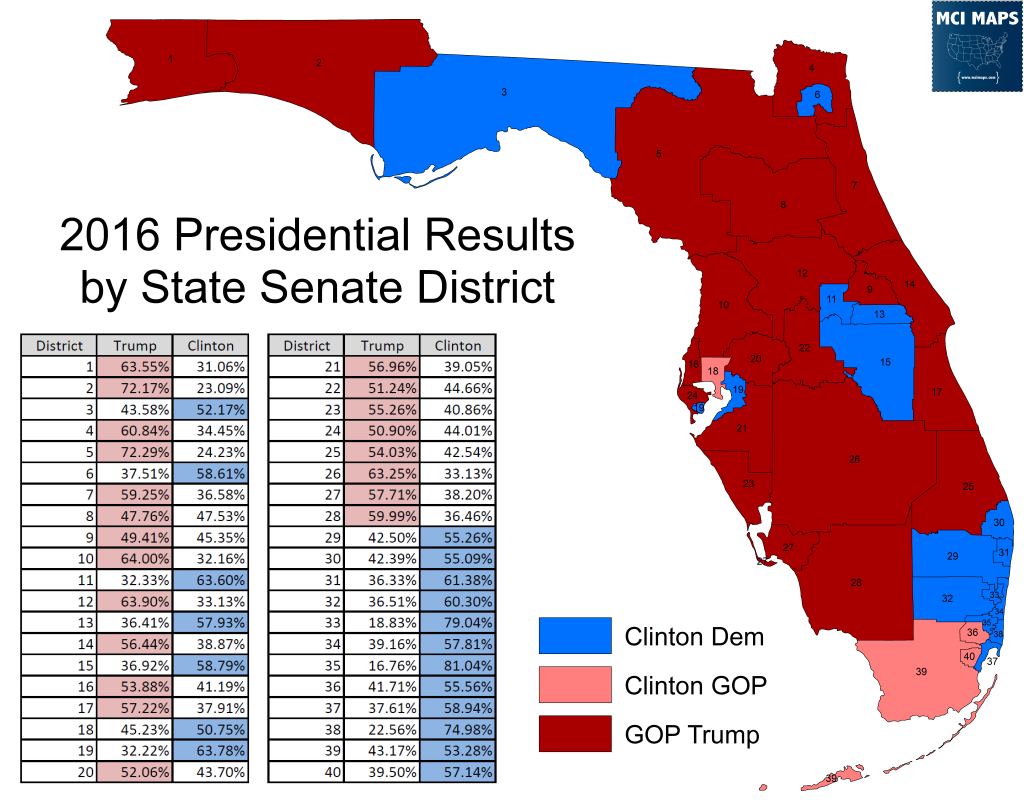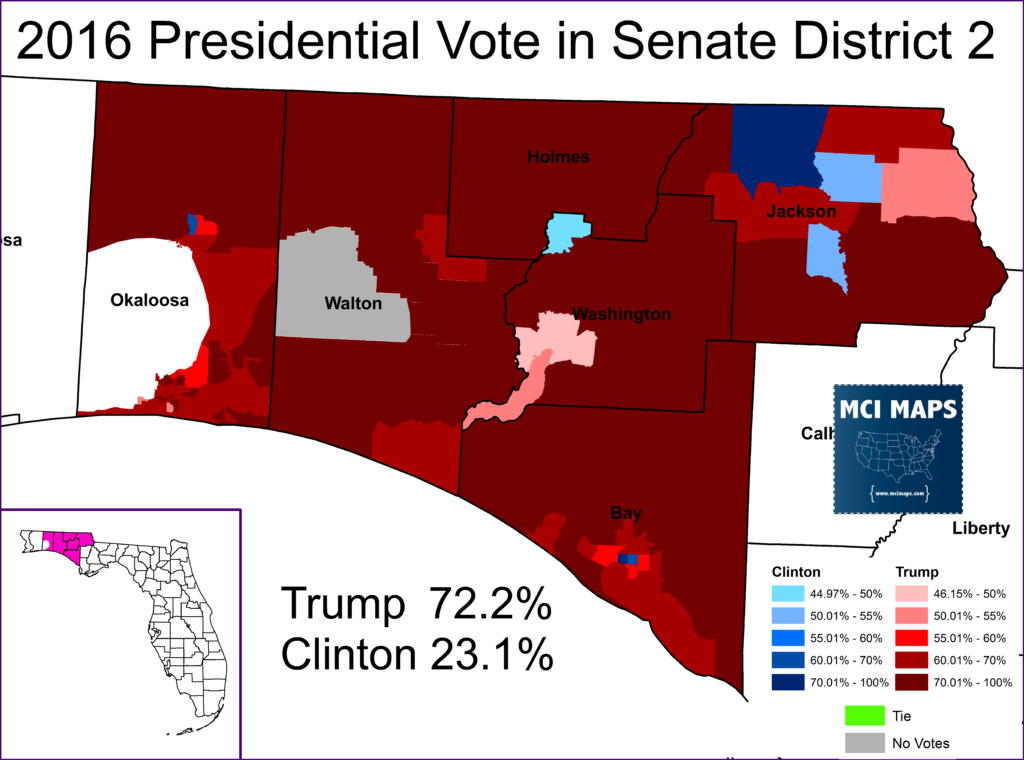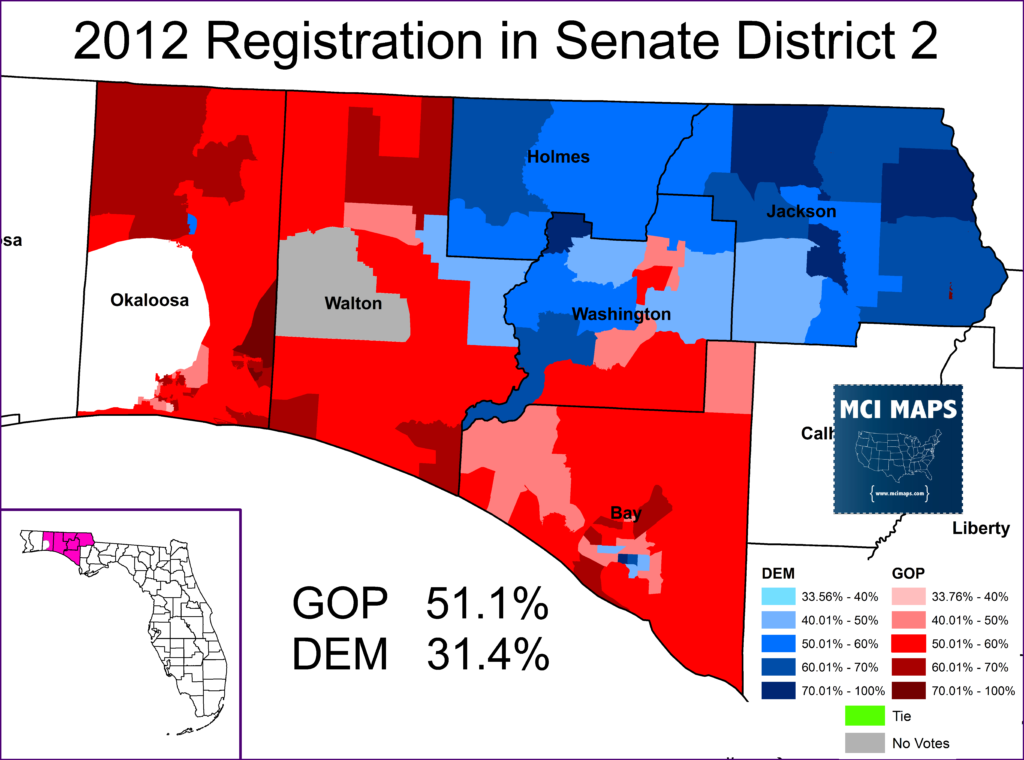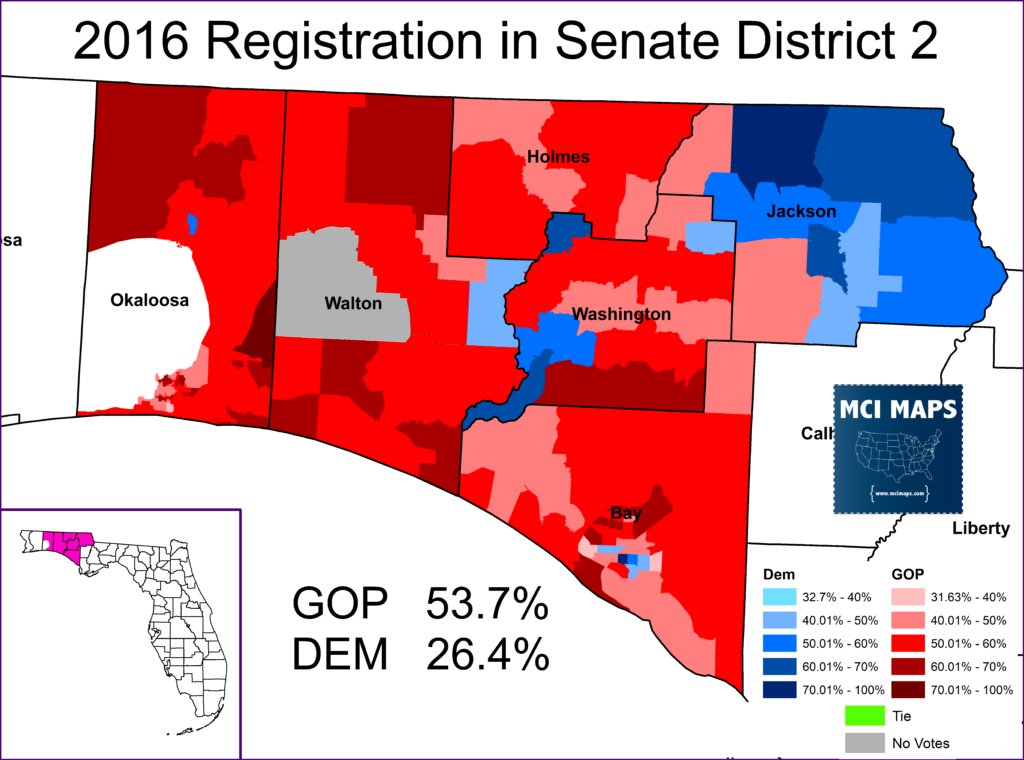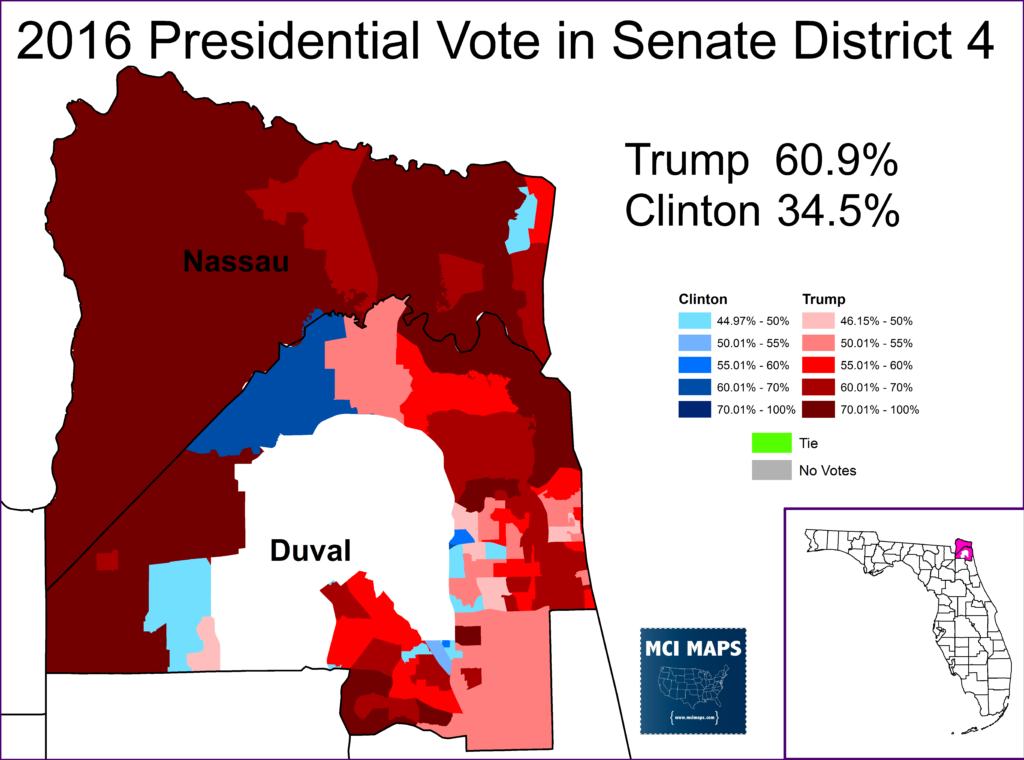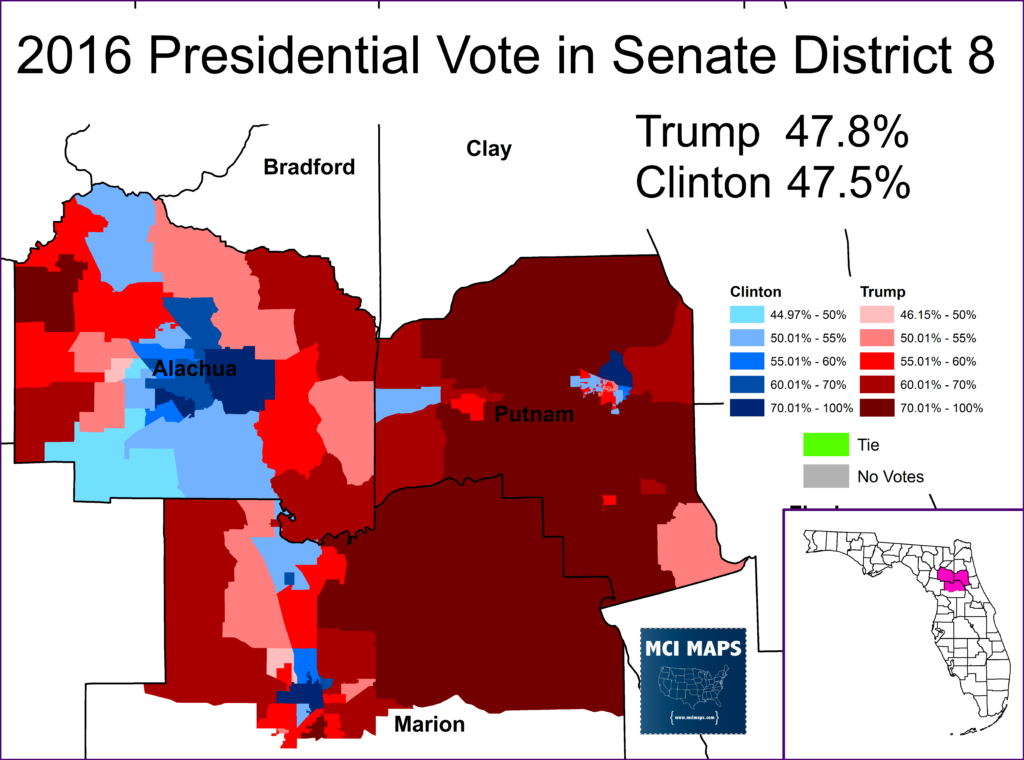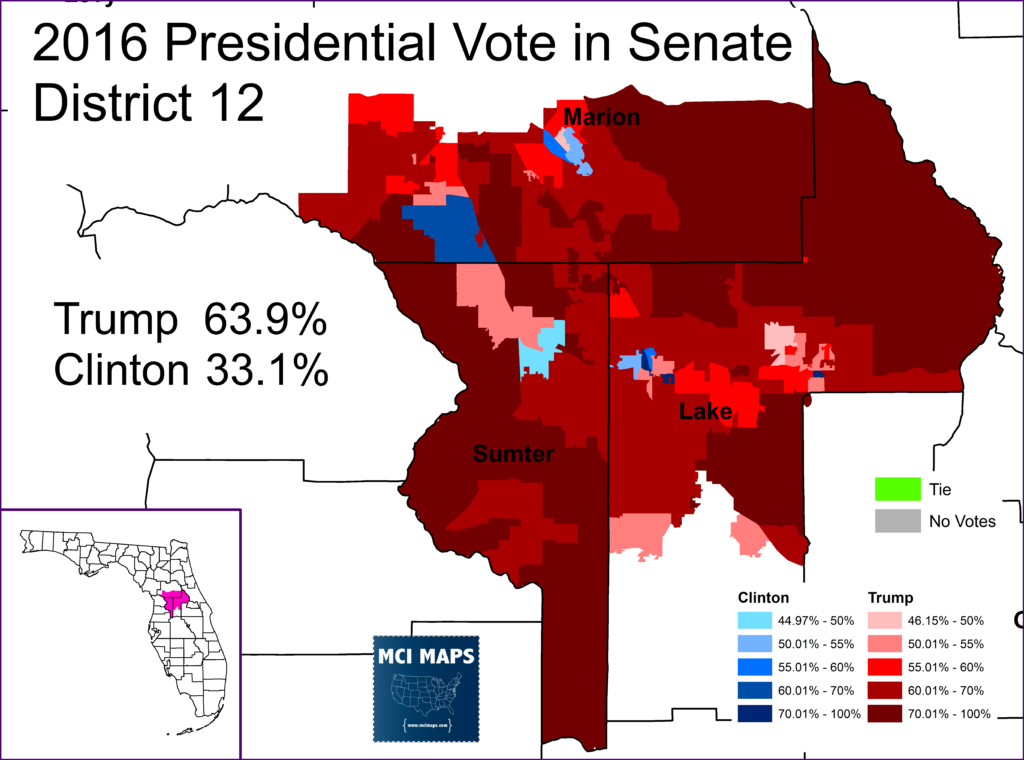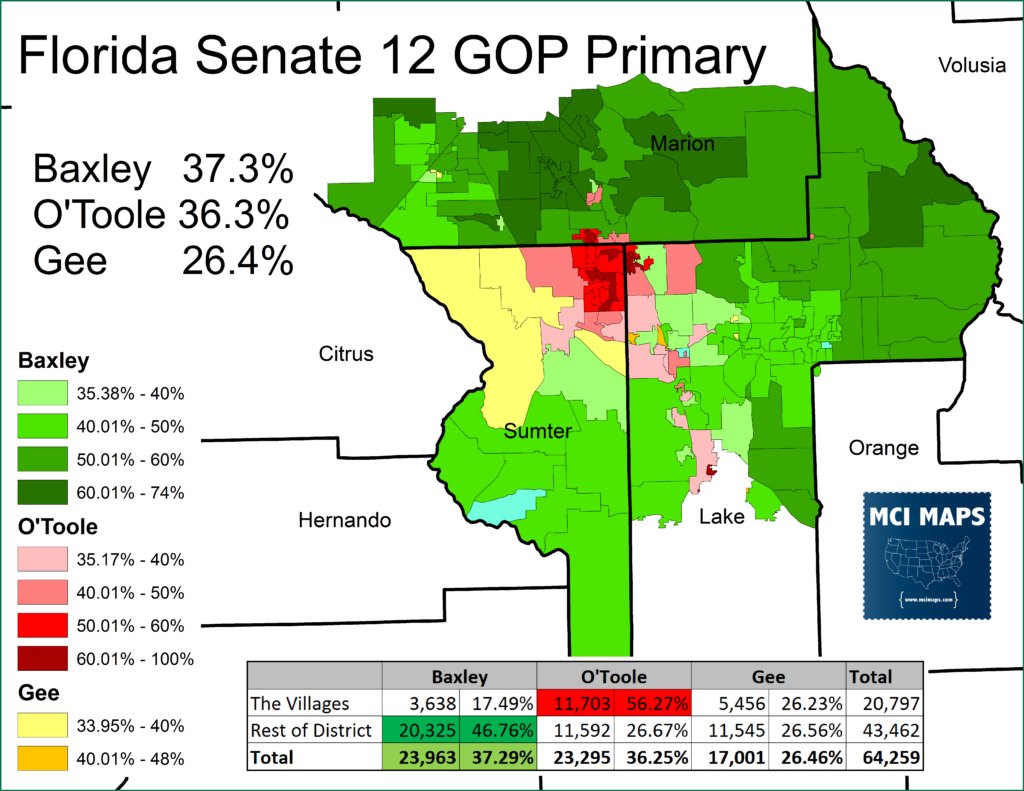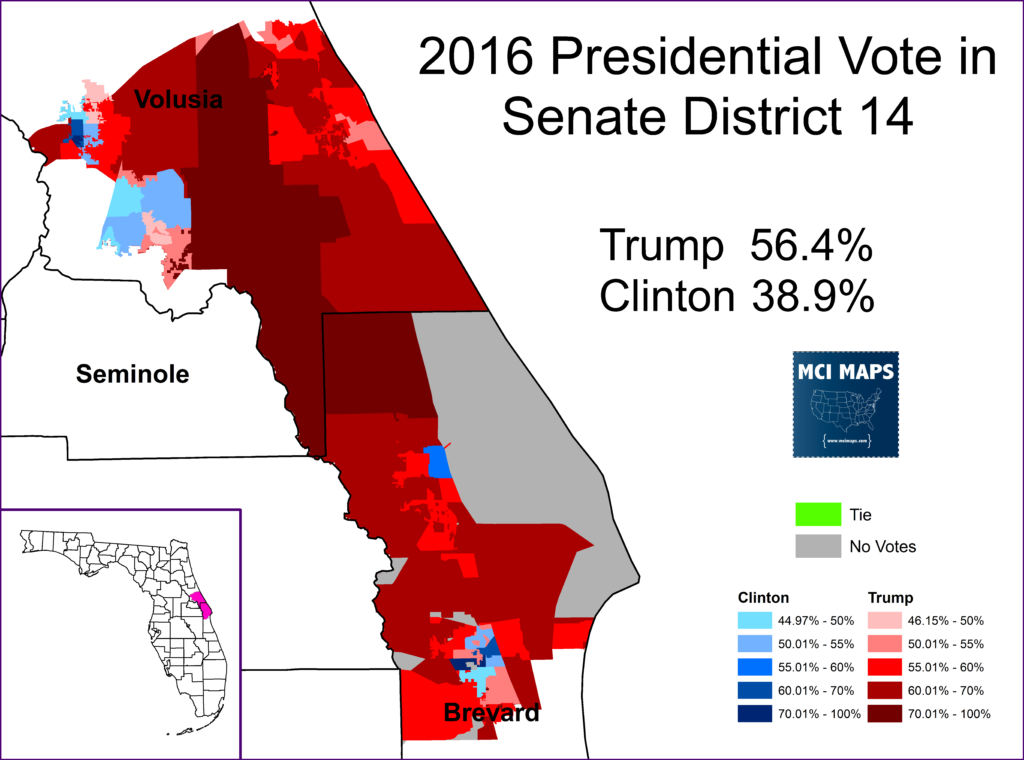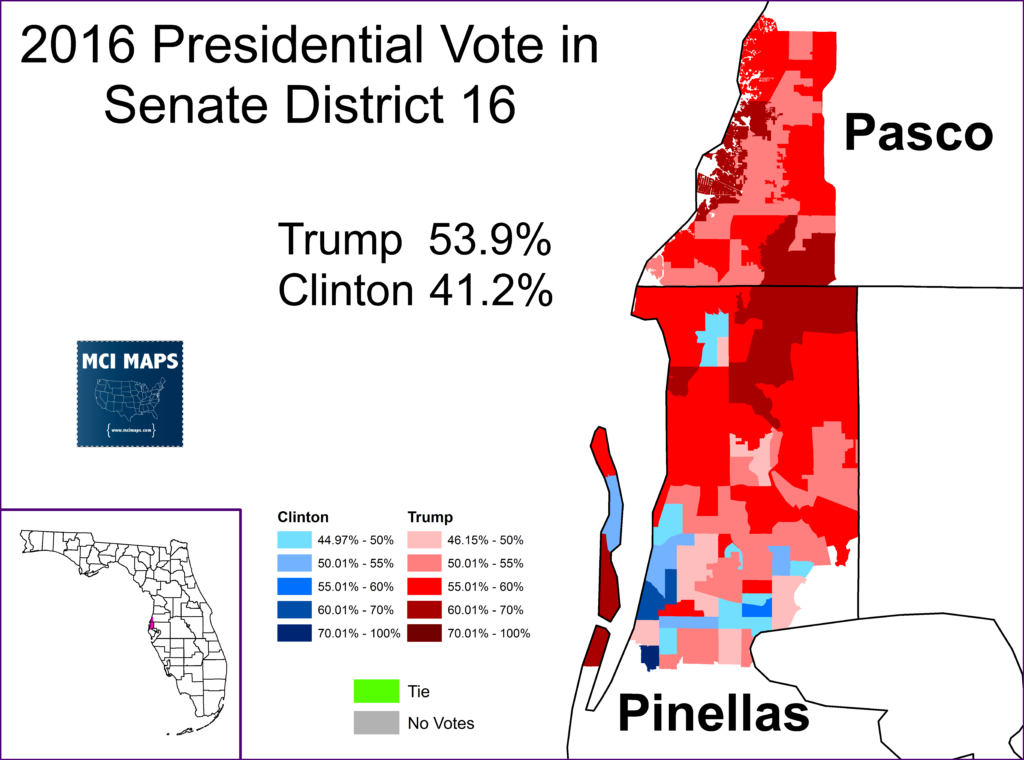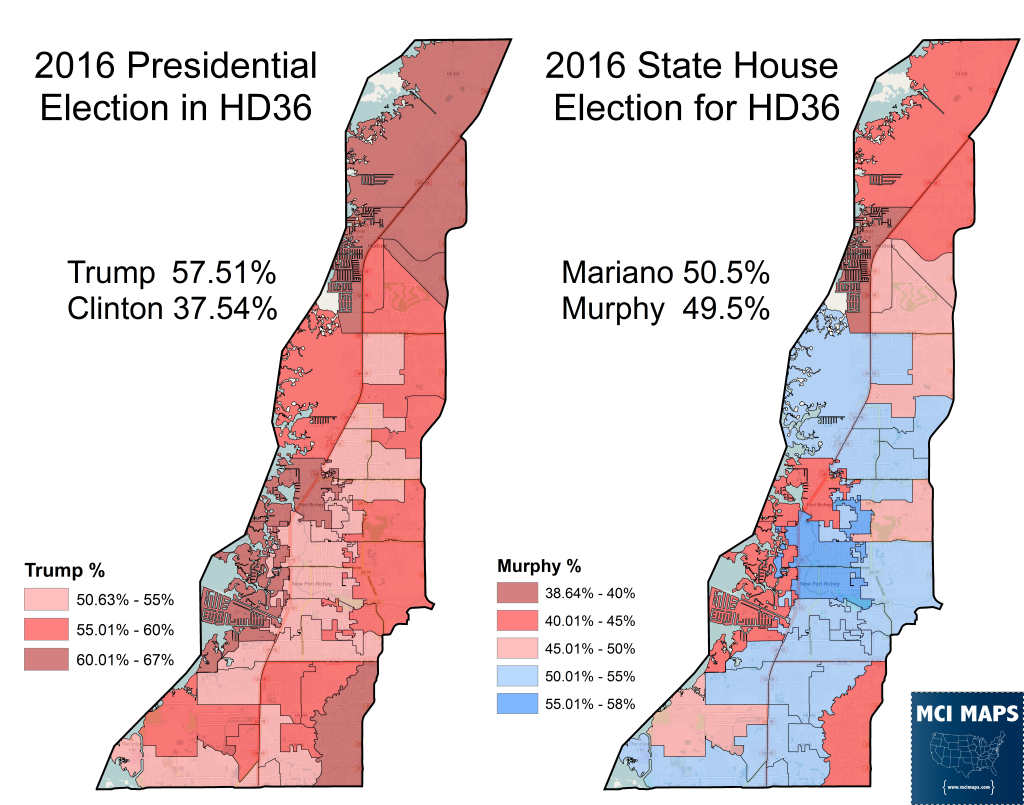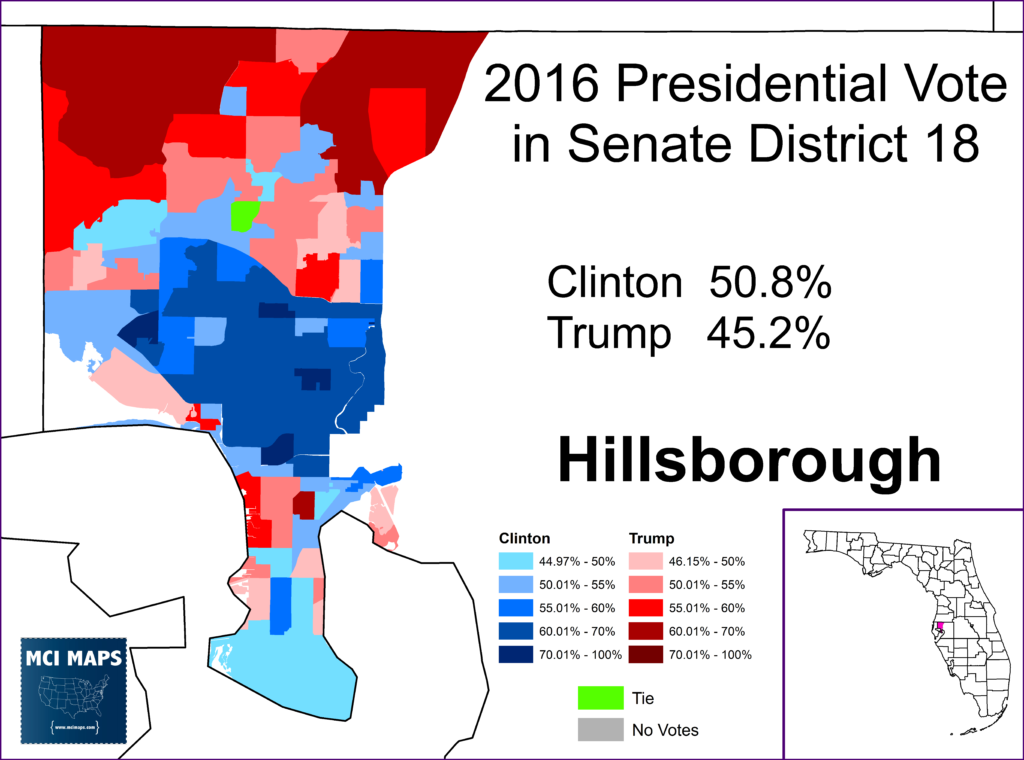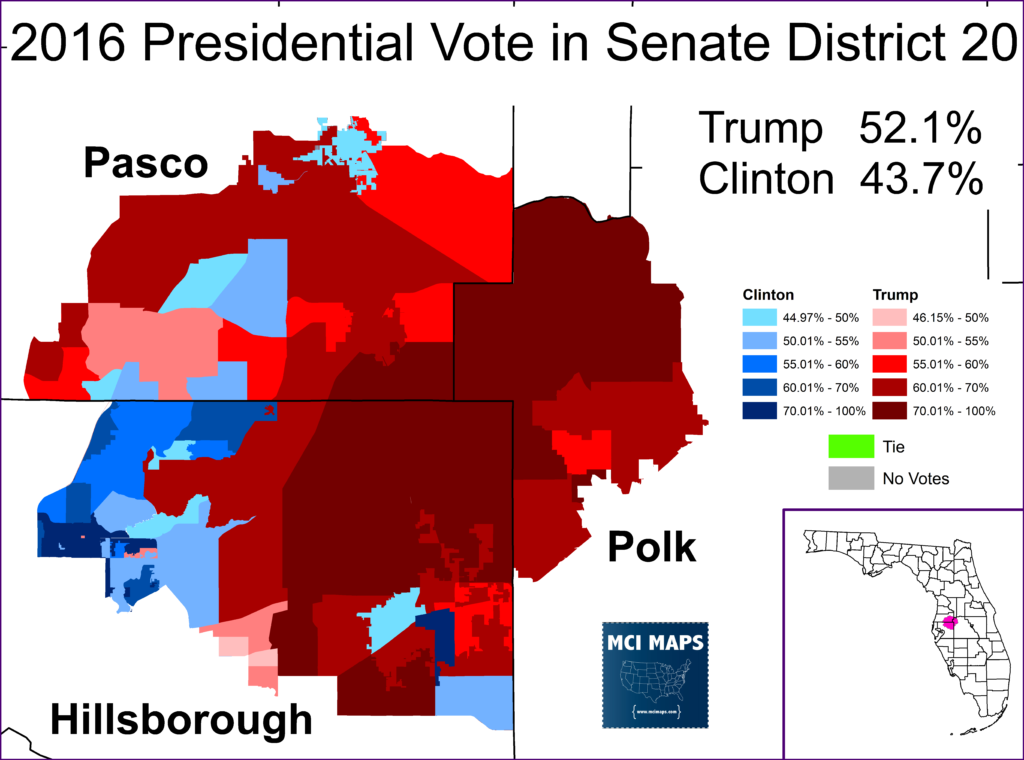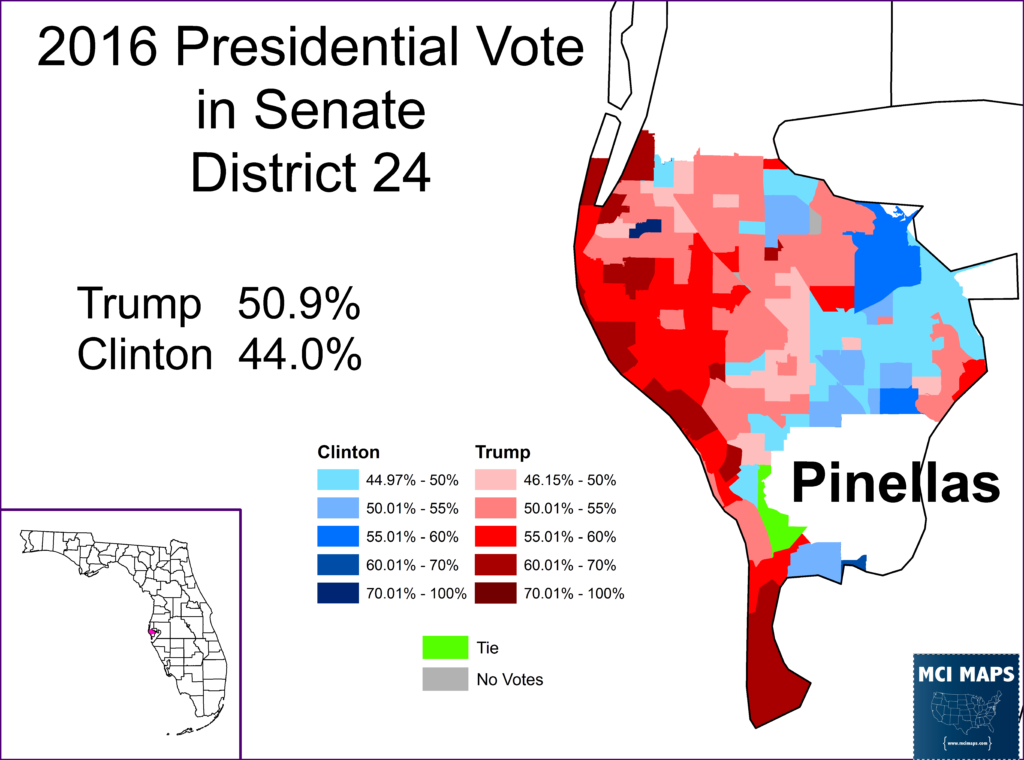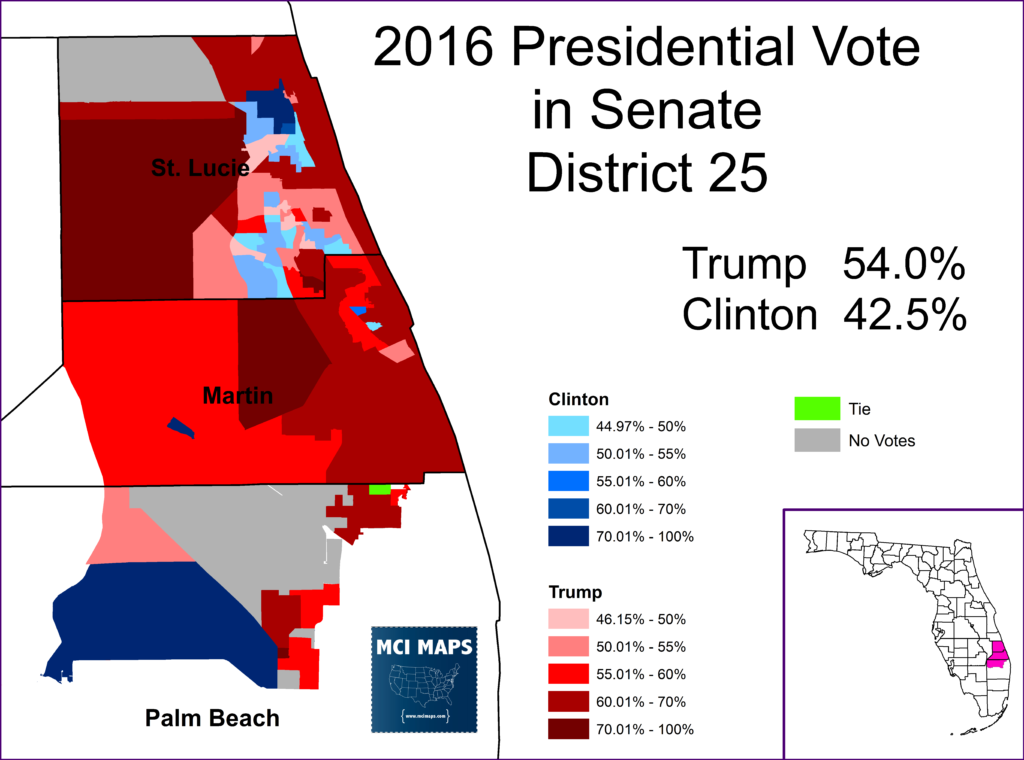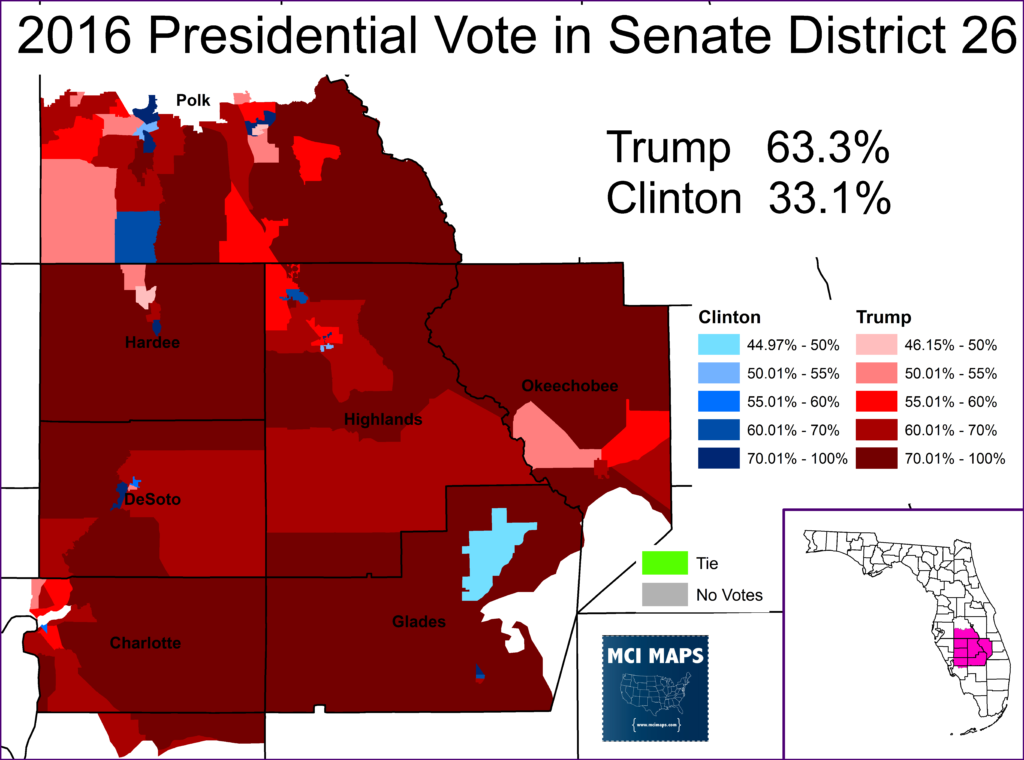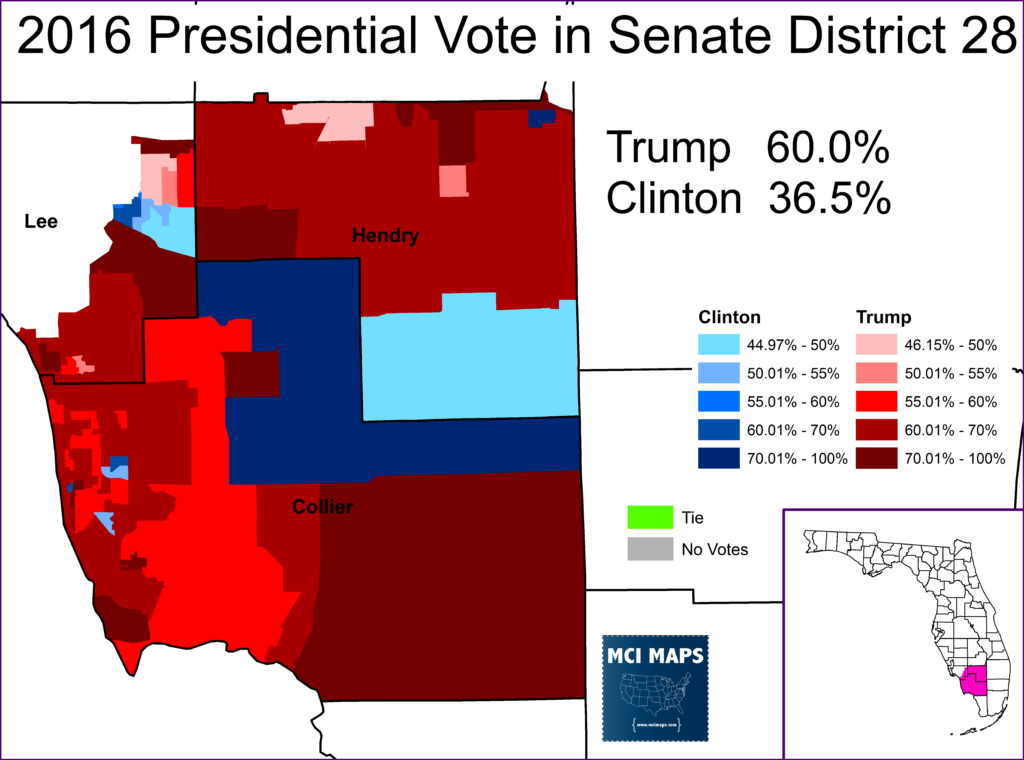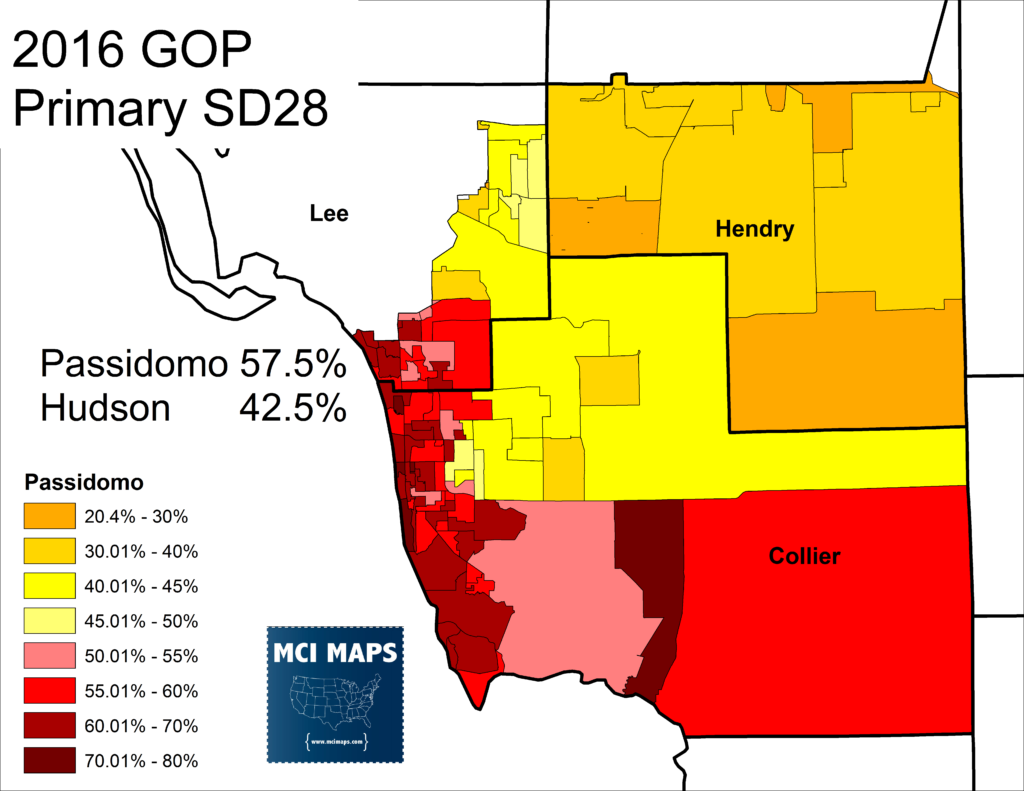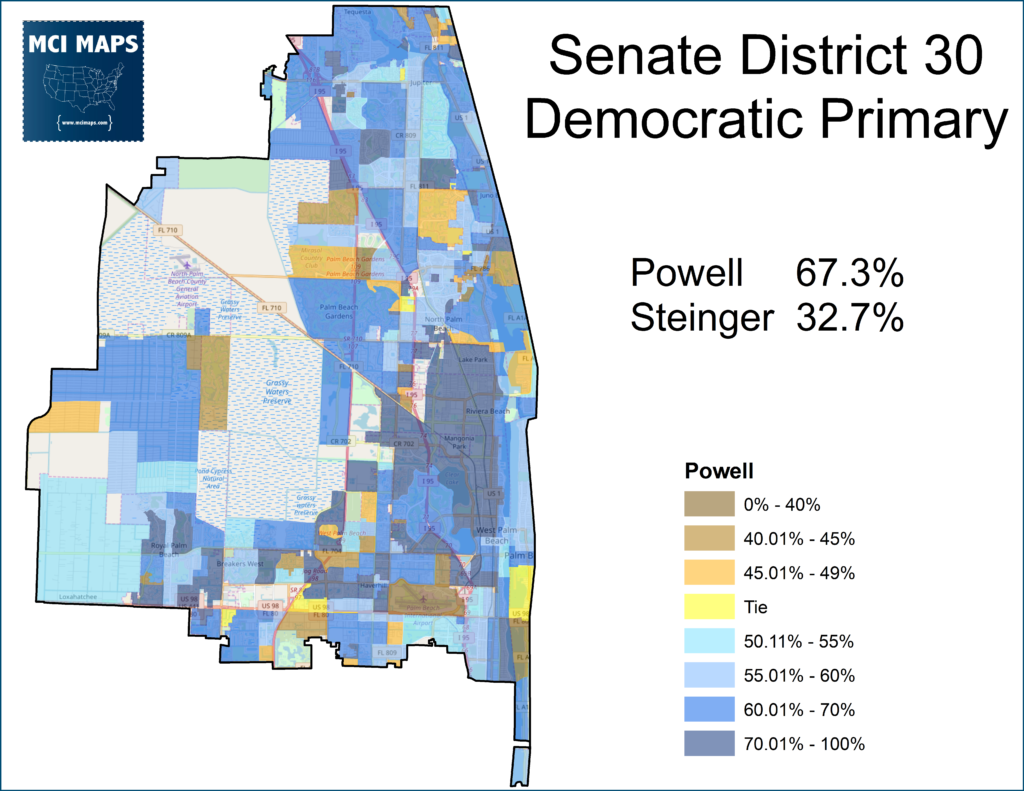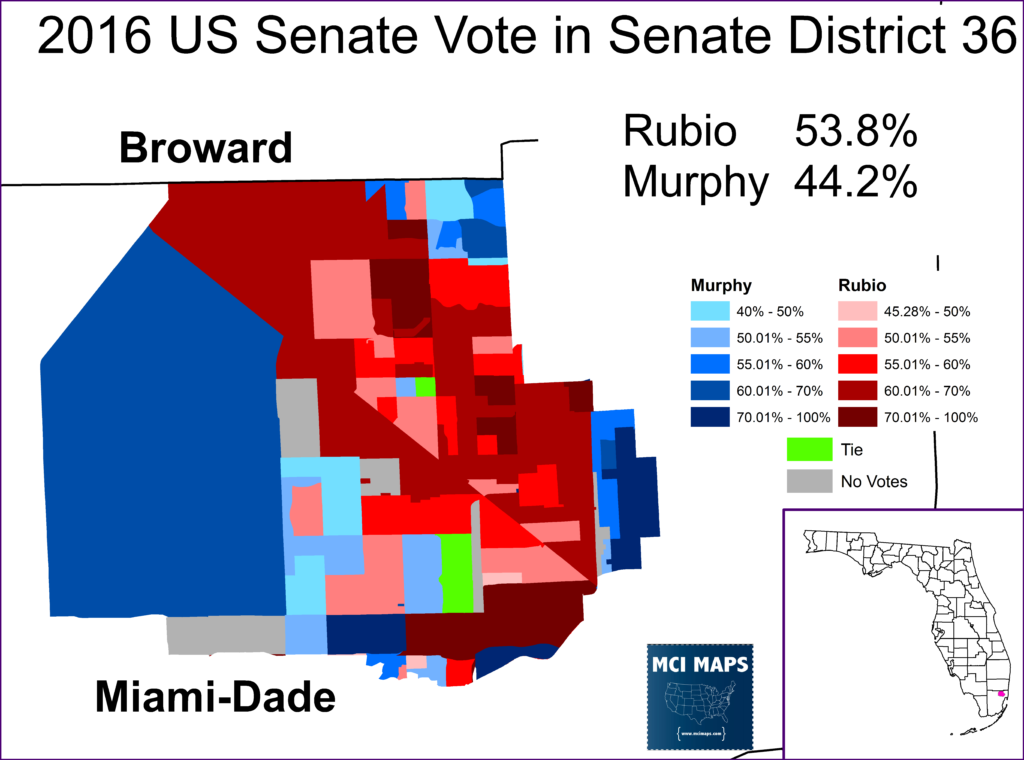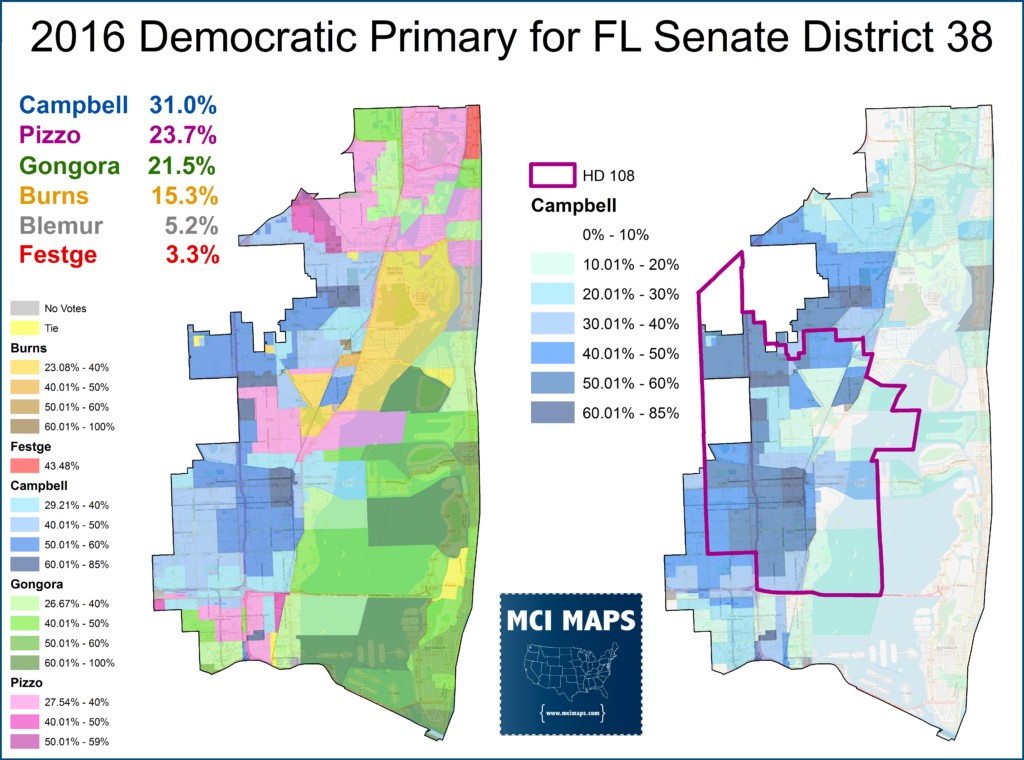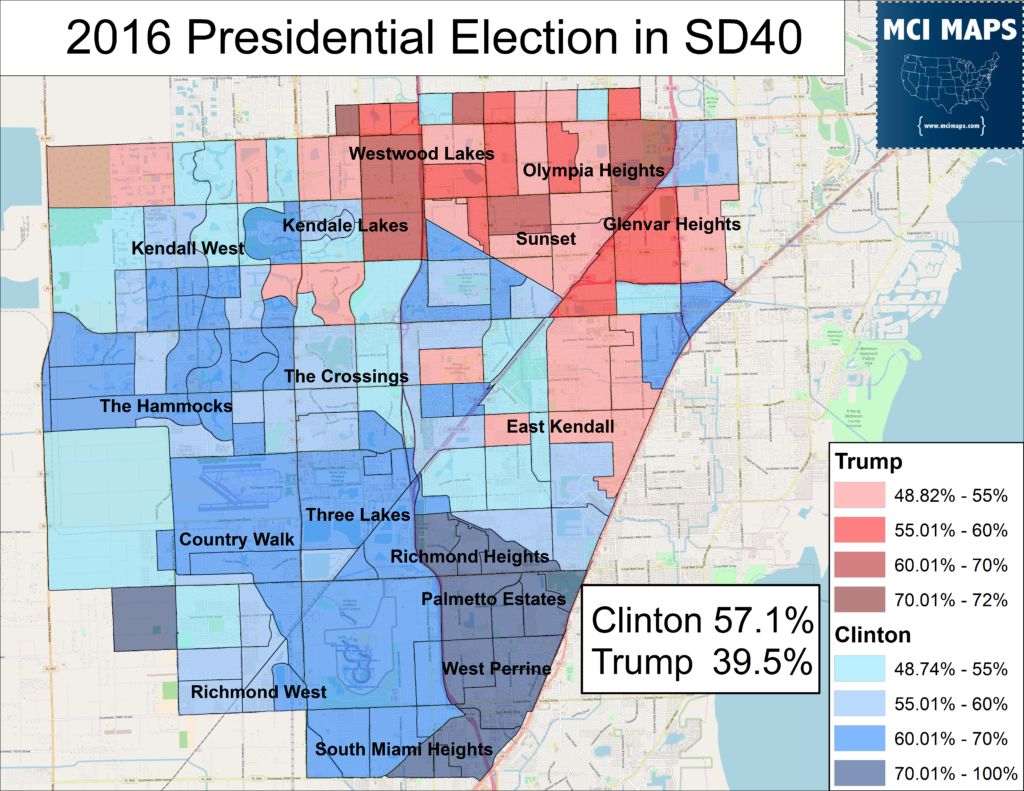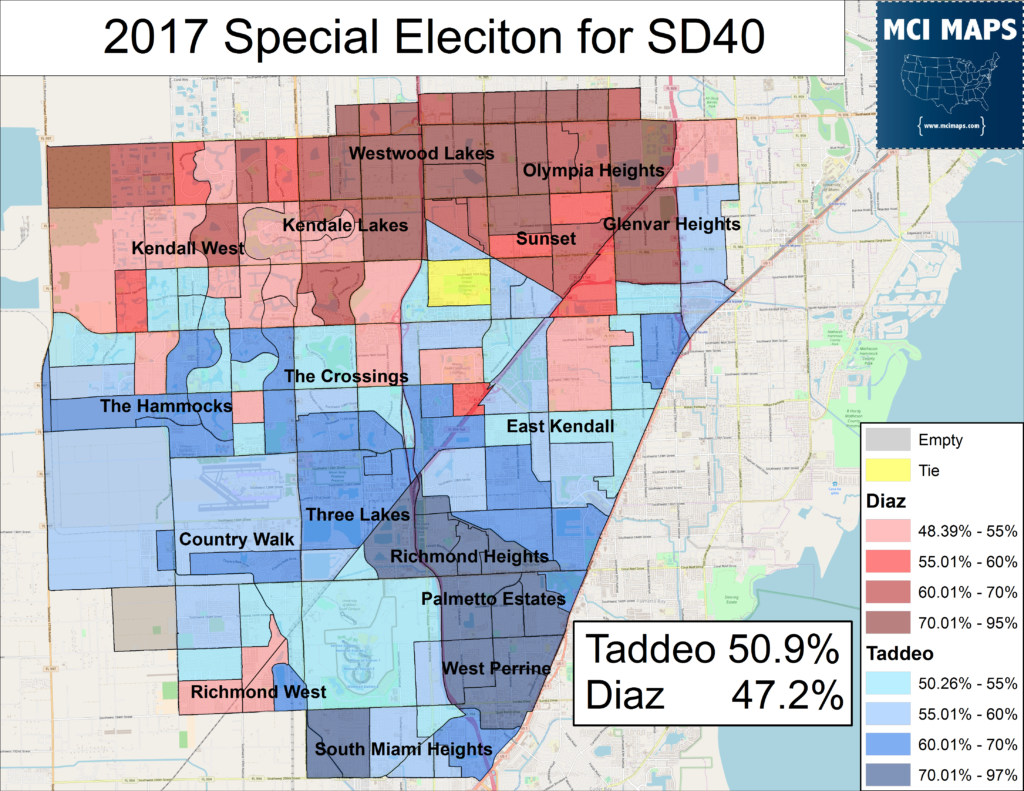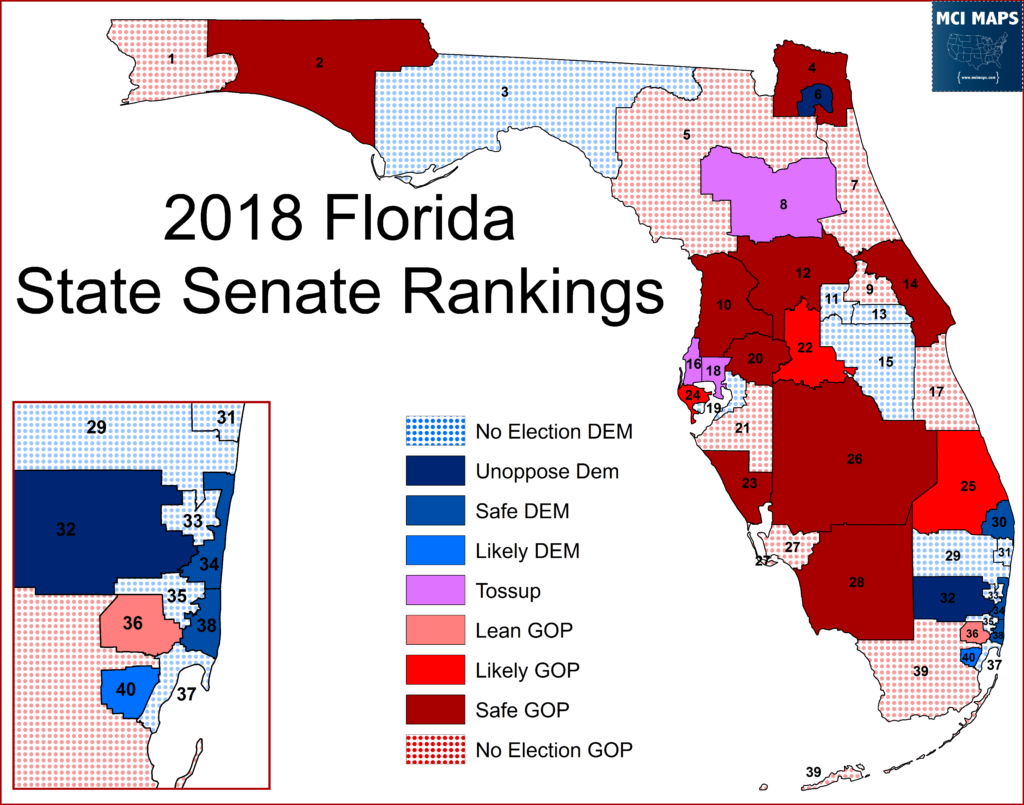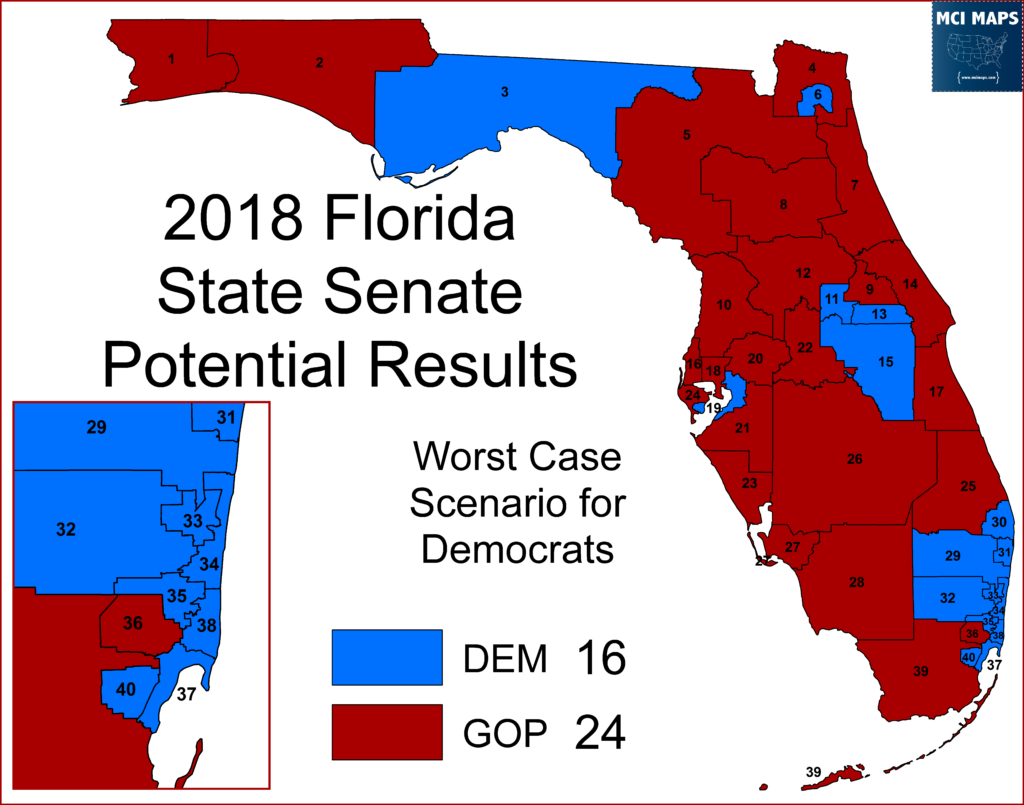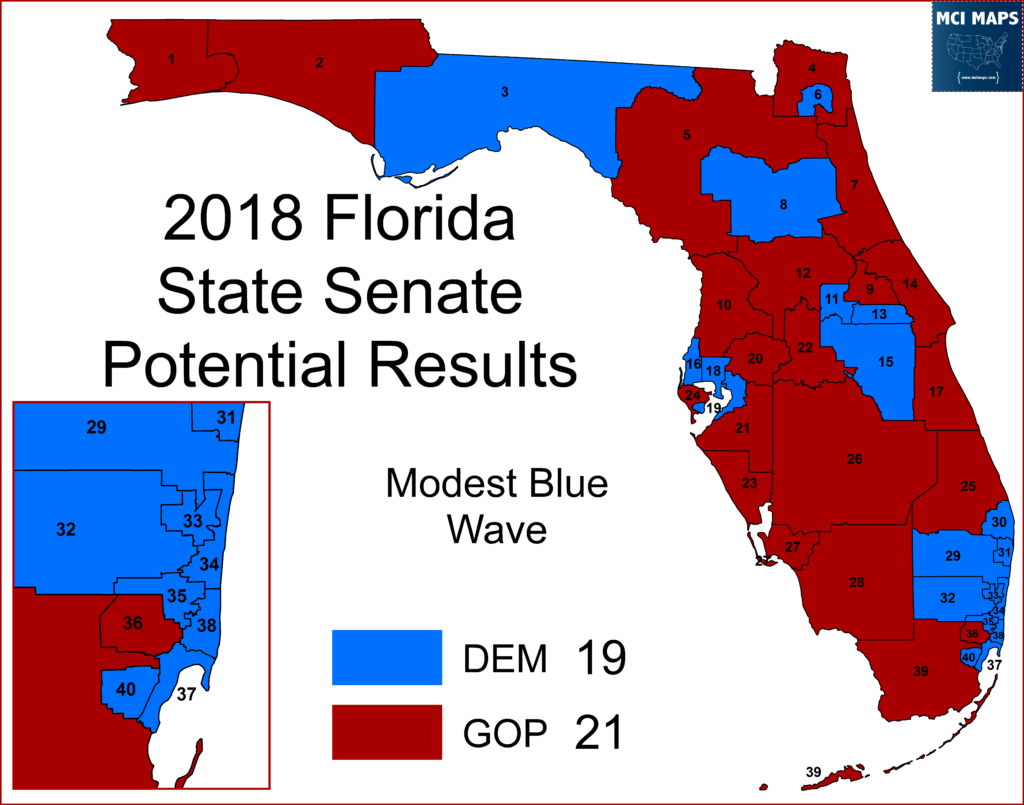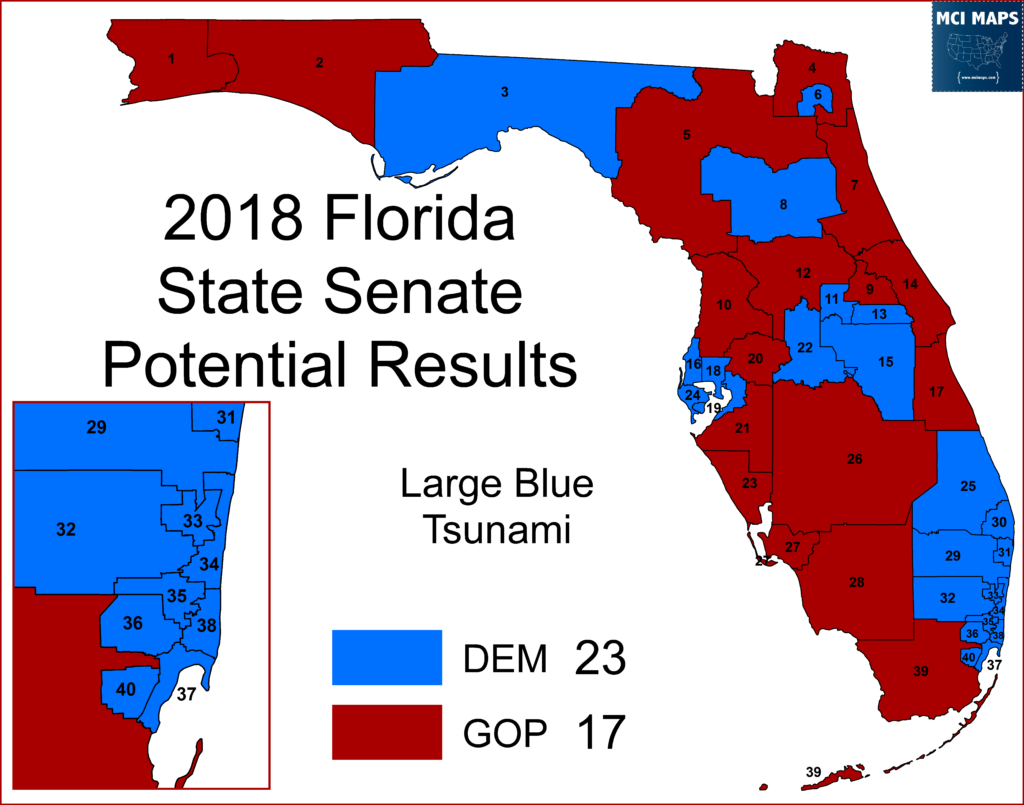This election cycle, just over half of Florida’s state senate districts are up for election. Florida State Senators are elected to four years terms, with even numbered districts up in the midterms and odd numbered districts up in Presidential cycles. In addition to the even districts, two seats are holding special elections at same time for half-terms. In the 2016 Presidential election, 21 seats backed Trump; while 19 backed Clinton. The map was put in place in 2016 after a mid-decade redistricting stemming from a lawsuit.
After the 2016 election, 4 Republicans sat in Clinton districts. One was based in Tampa, while the other three were Hispanic majority districts based in Miami-Dade (where Cuban politics plays a major role).
Since then, Democrats actually picked up the 40th in a 2017 special election. Meanwhile, the 18th and 36th are up.
At the moment democrats control 16 Senate Seats, Republicans control 23, and one (held by a Republican before then) is vacant.
Democrats are taking aim not just at Clinton-won seats, but also at several districts that voted for Trump. Republicans, meanwhile, are almost entirely on the defensive.
Lets look at each district one-by-one.
State Senate District 2
Until the week of qualifying, the 2nd Senate district of Florida appeared to be on the verge of going unopposed. Republican incumbent George Gainer, a former Bay County commissioner, had won the seat in 2016 with no opposition. Democratic attorney Mary Gibson filed against Gainer just a few days before qualifying ended. The district, based out of the Florida panhandle’s rural and military coast counties, is one of the most Republican state senate seats in the state. It gave Trump his 2nd highest share of the vote, but gave Clinton her worst share. The district had a 5% “other vote.”
The district continues to move to the right. It saw Trump improve over Romney. Democrats used to have registration advantages in Holmes, Washington, and Jackson Counties – which saw conservative dems vote blue locally but GOP at the top of the ticket – but registration shifts as well. The 2012 Registration map is below, followed by the 2016 registration map.
Jackson remains the loan Democratic-registration county in the district. However it is solidly GOP at the top of the ticket.
Gainer sits on over $100,000 and can easily raise more if needed. For Democrats the desire to give their side something to show up and vote for. But an actual win is off the table.
Rating: Safe GOP.
State Senate District 4
State Senate 4 is likely to see another sleepy Senate election. Republican Senator Aaron Bean is running for re-election in Florida’s most Northeastern district. The seat includes all of Nassau County and the whiter suburbs of Duval. The seat is solid GOP, giving Trump 60% of the vote.
This was actually a marked improvement from 2012 for democrats. Romney got 65% of the seat. However, Obama was at 33%. Clinton only did 1% better, but Trump fell thanks to a rise of 3rd party protest votes in the suburbs of Duval.
Bean has done little to attract negative attention to himself. He is facing a primary from a former Nassau County tax collector candidate, Carlos Slay. Slay has made all kinds of accusations of corruption toward Bean and others in Nassau government. Slay, however, is not a serious candidate; garnering 9% in his Tax Collector race and raising no money for his Bean primary. Bean’s democratic opponent, Billee Bussard, and a libertarian challenger, are no real threat to him. He is expected to win easily.
Rating: Safe GOP
State Senate District 6
State Senate District 6, held by Democrat Audrey Gibson, is not being challenged and has won unopposed.
State Senate District 8
State Senate District 8, based around Gainesville, is the first of the competitive races. The seat is a classic swing district. It narrowly voted for Trump by 0.3% in 2016 while backing Obama by 1.3% in 2012. In both instances the winner did not receive a majority. The district’s democratic base is located in Alachua, the county that holds Gainesville and the University of Florida. The district also includes Putnam County, an ancestral Democratic county that has been moving much quicker to the right. The district also hosts Northern Marion County and the city of Ocala – with the African-American precincts in western Ocala being the biggest source of Dem votes.
The 2016 State Senate election saw GOP State Rep Keith Perry take on former Democratic State Senator Rod Smith. Smith had a long political history in the region. He had been elected State Attorney (prosecutor) in 1992 and prosecuted the ‘Gainesville Ripper’ – a serial killer who terrorized the UF campus by killing several college students in horrifying methods. Smith was eventually elected to the state senate, ran for Governor (but lost the primary) and was Chair of the Florida Democratic Party at one point. Smith was considered a first class recruit for Democrats. However, in the end, Perry won by an easy 5%.
Smith under-performed Clinton in Alachua. A large part of this was that third party votes, concentrated in more GOP-aligned suburbs, went to Perry. Smith’s rural appeal did help him over-perform in Putnam and Marion, but by very modest margins. The Alachua margin was simply not strong enough. Perry’s Gainesville ties aided his better showing in Alachua County.
This go around, Perry is being challenged by doctor and healthcare advocate Kayser Enneking. She has already raised over $300,000 in her effort and both parties expect a fierce competition for the seat. Perry is strong but Democrats are making this race one of their top priorities.
Rating: Tossup
State Senate District 10
The 10th District saw the largest swing toward Donald Trump in the state. The district, based out of the working-class counties of Citrus, Hernando, and Pasco; went to Donald Trump 64% – 32%. This was an 8 point improved for Trump over Romney, who took the district 56% – 42%. Not a single precinct backed Clinton.
The Republican Incumbent, Wilton Simpson, is poised to be the GOP leader in the 2020-2022 legislative session. His lone challenger is Democrat Michael Cottrell; who said he was challenging Simpson to give the voters a choice.
Rating: Safe GOP.
State Senate District 12
State Senate District 12 is another solidly Republican seat based in North-Central Florida. The district includes southern Marion, most of Lake County, and all of Sumter. The district is home to The Village, a large retirement community based in the Northeastern Corner of Sumter. The district gave Trump 64% of the vote.
The seat’s current Senator is Dennis Baxley, who won the open race for the newly-created seat in 2016. Baxley, a state Rep from Marion at the time, defeated state Rep Marlete O’Toole. Both O’Toole and David Gee hailed from the Villages (a huge GOP-friendly retirement community in Northeastern Sumter), and the split in their vote (where Baxley got a distant 3rd) allowed Baxley to win. The primary map below shows O’Toole’s strength, which almost perfectly outlines the Villages.
Baxley is one the most conservative members of the Senate and has drawn controversy for his views on race. Baxley notably stopped a push for a slavery memorial to be erected in 2017, but changed his position for this session (the measure then passed). Baxley, despite his controversies, drew no GOP challenger and his democratic opponent, Gary McKechnie, is a serious underdog in a solidly Republican district.
Rating: Safe GOP.
State Senate District 14
Senate district 14 covers southern Volusia County and northern Brevard. Volusia used to be much stronger for Democrats, voting for Obama in 08 and narrowly for Romney in 2012. However, like other white-working class counties, the area swung heavily to Trump in 2016. This pushed the district from a modest 53-46 Romney to a more daunting 56-39 Trump victory.
Even if the state moved back into more purple territory, its unlikely GOP State Senator Dorothy Hukill is at risk. She sits on a strong war-chest and her democratic opponent, Melissa Martin, only has $30,000 raised. Hukill underwent treatment for cancer in 2017 and has a strong level of goodwill.
Rating: Safe GOP.
State Senate District 16
Senate District 16 is shaping up to be one of the premier battlegrounds this November. The district was always slated to be an open race due to term limits, but the seat has actually been vacant most of the year following the resignation of Jack Latvala. Latvala was forced to resign after numerous women came forward to accuse him of sexual harassment. Investigations found possible evidence of trading sex for votes. Latvala finally resigned in the wake of the threat of expulsion. His district, based out of North Pinellas and Southwestern Pasco County is a modestly GOP seat that swung to the right in the last election. The district had voted for Romney by a 50-48 margin, but wound up backing Trump 54-41. Trump’s gain was smaller than Clinton’s drop as third party votes increased. The seat’s large white-working-class base in Pasco and longtime GOP-aligned voters in North Pinellas allowed Trump to secure a double-digit win. The area around Clearwater, at the southern portion of the district, is the most Democratic region of the district – but it to moved toward Trump.
For Democrats, the key to having a shot in the district was a good recruit. They got that in former HD36 Representative Amanda Murphy. Murphy represented a district that includes all of the coast of Pasco County. She represented the Pasco-portion of SD16 up until 2016. She initially won an expensive special election in 2013, survived a challenge in the 2014 midterms, but lost re-election last year. Her district saw one of the largest swings against the Democrats – voting for Obama in 2012 and then voting for Trump by 20 points. Murphy lost by 1%, outperforming Clinton by 12 points.
Murphy lost but her over-performance still made her a very attractive recruit. She will face off against former GOP state Rep Ed Hooper. Hooper subsequently lost a bid for Pinellas County commission in 2014 – so both candidates have wins and losses on their resume. Hooper has a massive financial advantage, but outside groups are likely to get involved. A St. Pete polls survey had the race within 2 points; 45 Hooper, 43 Murphy.
Rating: Tossup
State State District 18
Right next door to SD16 is Senate District 18 – the home to the biggest battleground on the map. The district includes western Hillsborough, taking in eastern and downtown Tampa. Meanwhile, Clinton secured 51% of the vote in the district with Trump at 45%. This was an improvement fro Democrats over Obama’s 50-49.
GOP State Senator Dana Young won her 2016 election with a 48% plurality win. Democrat Bob Buesing took 42% and a third-party candidate Joe Redner, took 9%. Redner has support from assorted progressive groups, despite having a position profile that more libertarian style. Precinct analysis indicates Redner took more from Democrats than Republicans, but Young would likely have won with a bit over 50% in a 2-way race.
Democrats convinced State Rep Janet Cruz, the outgoing leader of the State House Democrats, to run against Young. Both candidates are strong fundraiser and heavyweights in this part of the state. Young has tried to push a moderate image with environmental issues but her opposition to gun control programs have earned her the ire of the #MarchforOurLives movement. The race is already neck-and-neck, with Cruz leading Dana Young 44-43 in a recent St. Pete Poll.
Rating: Tossup
State Senate District 20
State Senate district 20 is a modest GOP seat that takes from three counties. It takes in Southeastern Pasco, Northeastern Hillsborough, and Northwest Polk. The seat is held by Incumbent Tom Lee, a former Senate President and longtime politician from the region.
The district hosts a strong democratic block of votes around the New Tampa, Temple Terrace, and the University of South Florida. The swing of rural communities to the right made the district more GOP-friendly. The district backed Romney by a much more modest 51-48 margin. Democrats are not making the district a priority though, as Lee is a well-known politician who has not demonstrated any vulnerabilities.
Ranking: Safe GOP
Senate District 22
The 22nd State Senate district covers Southern Lake County and much of Northern Polk. It includes the cities of Winter Haven and Lakeland. The district is a mix of rural conservative whites and Hispanics; who are largely based in the districts eastern precincts. The district went for Trump 51-44 after being much closer in 2012 (Romney 50.8% to 48.6%).
For Democrats, there is a pathway to victory in the seat. The Democrats will likely nominate former Judge Bob Doyel, who so far has done a decent job raising money. Incumbent Senator Kelli Stargel isn’t taking the race lightly, however. For Democrats, a big issue is ensuring good Hispanic turnout – which normally has a notable drop in midterms. Hispanic turnout was a problem for Democrats in the HD39 special, which overlaps with this seat. Democrats need good Hispanic turnout and Doyle is expected to do better with rural whites than Clinton did. Right now, the race is a dark horse and definitely something to keep an eye on. However, Democrats need alot to go right.
Rating: Likely Republican
State Senate District 23
State Senator Greg Steube is resigning the State Senate to run for Congress – leaving his 23rd district open despite being an odd-numbered district. The seat is based out of Sarasota County and includes western Charlotte. The seat includes Democratic pockets in Northern Sarasota and hosts House District 72, which Democrats picked up in a special election earlier this year. However, outside that bright spot for Democrats is a very conservative block of voters further to the south. The district was solid for Trump, going to him by a 15% margin.
State Representative Joe Gruters is the only Republican to file. Democrats have disability activist Faith Babis. Its a very tough district for democrats and is expected to stay in GOP hands.
Ranking: Safe GOP
State Senate District 24
Senate district 24 was subject of much debate during the 2015 redistricting saga. Incumbent Republican Senator Jeff Brandes lucked out when the courts didn’t order the African-American communities of South Pinellas (which are connected to a seat based in Hillsborough.. across the water) to be joined into the 24th. This leaves the 24th district a mixture of white working class communities, coastal homes, and democratic suburbs. The district, which originally backed Obama by less than 1% in 2012, swung toward Trump in 2016 as white working class voters moved away from Democrats.
Senator Brandes is a prolific fundraiser and is personally wealthy; allowing him to self-fund if needed. He has strong ties in the district and is an aggressive campaigner. This makes challenging him daunting. His opponent is Democrat Lindsay Cross, who is an executive in the environmental community. Cross actually just recently jumped in, replacing Democrat Carrie Pilon; who had to withdraw due to family medical issues. Cross has to quickly catch up in fundraising. Right now there is a path for Democrats, as recent polls only put Brandes at 39% and Cross at 19%.. which large numbers undecided. However, the question will be if Democrats or left-leaning groups invest in a race where the Incumbent (who is going to be running for his last term) can self-fund. There is a path for Cross, but right now its up to her campaign to show its viability.
Ranking: Likely Republican
State Senate District 25
Outgoing Senate President Joe Negron has opted to resign now that is term as President is up. This has opened up the 25th district, which normally wouldn’t be open till 2020. The district includes all of St. Lucie County, Martin County, and some of Northern Palm Beach. By far the largest block of votes in the district is St Lucie and Martin. St Lucie took a strong swing to the right in 2016, going from a reliable blue county to a Trump county. The swing was thanks to St Lucie’s large white-working-class block of votes. This cause the seat to go from Romney +3.5 to Trump +11.
Democrats have a strong candidate is Robert Levy, a physcian with strong ties in Martin County. Levy has also put $150,000 of his own money into the race. Meanwhile, the GOP primary for the seat has gotten nasty and expensive. State Representative Gayle Harrell, based out of St Lucie, is in a fight with Belinda Keiser, the Vice-Chancellor of Keiser University. Keiser has spent over $900,000 of her own money to win the primary. It all seems to be for nothing, as polls put Harrell ahead by large margins. The vicious fight could give Democrats an opening. However, Harrell will be a strong nominee and the district still leans to the right. Like SD22, this could be a dark horse.
Ranking: Likely Republican
State Senate District 26
What is perhaps most shocking about the election for Senate District 26, a mammoth district that overs the farmlands of south-central Florida, is that despite the GOP incumbent not running for re-election – only one Republican has filed. State Representative Ben Albritton, who represents Hardee, DeSoto, and part of Polk; is running as the GOP nominee. The district is solid GOP; mixing GOP counties like Hardee, Highlands and Polk with ancestral Democratic counties like DeSoto and Glades (which still have local Democrats in office).
Albritton got a lucky break last year when State Representative Carry Pigman, who represents Highlands, Okeechobee, and Glades, was pulled over for drunk driving. Pigman could have mounted a campaign of his own, but the arrest killed any chance of that. Albritton is sure to walk into this seat.
Ranking: Safe GOP
State Senate District 28
Florida Senate District 28 is based out of Collier County, a steadfast GOP suburb with the county-seat of Naples. The district stretches into southeastern Lee and takes all of rural Hendry County. The district actually moved a few points toward Clinton in 2016 thanks to Trump’s weaker showing in suburbia. However, the district remains solid red and isn’t elastic enough to really give Democrats an opportunity.
When the new seat was created in 2016, Naples state representative Kathleen Passidomo ran for the seat against Hendry State Rep Matt Hudson. Both candidates win in the respective bases, but the larger vote share out of the Naples/coast region gave Passidomo the win.
Passidomo only faced a write-in for the general. This time she faces no primary and faces Democrat Annisa Karim. She is expected to easily win.
Rating: Safe GOP.
State Senate District 30
State Senate district 30 is a modestly Democratic seat located out of northern Palm Beach County. No Republican even bothered to file for the seat.
The seat was won by then-State Rep Bobby Powell. Powell faced self-funder Michael Steinger for the Democratic nomination in 2016 in a race many expected to fall on racial lines. Powell, who is African-American, represented a heavily black house seat and Steinger aimed to win the whiter suburbs outside Powell’s house seat. However, Powell ended up winning by an all-encompassing 2-1 margin.
This primary, Rubin Anderson is challenging Powell in the Democratic primary. Anderson has raised little money though, and its expected Powell will dominated in his re-election. The primary winner will face a write-in candidate in November.
Rating: Safe Democratic
State Senate District 32
State Senate District 32, held by Democrat Lauren Book, is not being contested. Senator Book has been re-elected unopposed.
State Senate District 34
State Senate District 34 is a solid Democratic seat that covers all of Broward Counties’ coast. It includes a handful of GOP-aligned cities along the Northern coast, but otherwise is filled with Democratic communities. No Republican filed for the seat and the primary winner will face a write-in in the fall. The primary is a rematch from 2016. Two years ago, lawyer Gary Farmer defeated former State Representative Jim Waldman and then-state Representative Gwen Clarke-Reed. The primary was primarily fought between Farmer and Waldman, who brutalized each-other in ads. The nasty campaign actually aided the underfunded Reed, who crept into 2nd. Reed would win in Deerfield Beach, the area she represented in the State House. Waldman, meanwhile would win scattered precincts. Farmer would easily win the three-way fight.
Farmer was originally expected to be re-elected unopposed, but Waldman filed to run right before qualifying ended. Waldman has loaned his campaign $150,000 and is also using a political committee to go after Farmer. Waldman has been falsey claiming Farmer voted against gun reform (Farmer voted no on a gun/security bill that passed after the Parkland School shooting). The reality is Farmer was a heavy pusher for an assault weapons ban and didn’t back the bill due to its more modest gun control and it allowing the arming of school teachers.
The race has been nasty, but polling shows Farmer is still expected to win the race.
Rating: Safe Democratic.
State Senate District 36
State Senate district 36 is based directly out of Hialeah, a city synonymous with the Cuban American community. The seat is one of 4 Hispanic-Majority districts; all of which are based out of Miami-Dade. This seat is one of the more GOP-friendly of the four. Like all things in Miami-Dade, the Presidential margins are decieving. Clinton won the district by 14%; a huge jump from Obama’s 4% win. This was thanks to Trump’s high dislike among Cuban Americans.
The same day Clinton swamped Trump, Republican Senator Marco Rubio secured a 9 point win. He did so by consolidating Hialeah, which has never voted for a Democrat.
Republican Senator Rene Garcia, a moderate Republican, also won his re-election by 10% that same day. However, Garcia is now retiring and the seat is open. Republicans have State Representative Manny Diaz Jr. Democrats have two candidates, but the party clearly wants David Perez to win the primary. Perez is the longtime aid to former Miami-Dade Mayor Alex Penelas. Democrats are hoping to make a play for the seat and see it as a pathway to their Senate majority. Democrats have seen great success in recent Miami-Dade elections; winning the 2017 special for Senate District 40, holding House District 114 in a special, and winning Dade County 5 in a special.
For Republicans, they have the benefit of a better funded Diaz and an expensive media market. The issue for Democrats is the seat is expensive to play in and if funds get tight, races further north might take priority.
I’m very torn on how to rank this. I want to say a tossup, but in my mind I say its advantage to the GOP.
Ranking: Lean GOP
State Senate District 38
State Senate district 38 is a solid Democratic seat based in North Miami-Dade’s coast. The seat is a melting pot of communities. It includes coastal communities of whites and hispanics as well as a more-inland set of voters that are heavily African-American and Haitian. The seat is over 70% Democratic and hence the Democratic primary is all that matters.
When the seat formed in 2016, it was won by Democratic State Representative Daphne Campbell. Campbell won the seat with 31% in a very cluttered primary – winning her base of support in the Haitian community. Campbell benefited from the coastal communities being split between Jason Pizzo – a prosecutor, Michael Gorgora – a Miami Beach commissioner, and Kevin Burns – a former North Miami commissioner. A Democratic primary is just over 50% African-American, but African-American candidates (Campbell and Blemur) only made up 36% of the vote.
Campbell is a very controversial figure in Democratic politics. Her family is under constant scrutiny for questionable business practices, she is socially conservative and is disliked the district’s large LGBT population, and she is very cozy with Republicans. She has an adversarial relationship with the press, calling the police on reporters who ask her questions at public events. Their is also much debate about if she lives in the district.
The controversy around her made a primary challenge a sure bet once she won in 2016. Pizzo, who came in 2nd last time, announced he would run. Once qualifying ended, no other candidates had filed. Campbell is largely expected to be vulnerable in a 1-on-1 primary. Her troubles became even worse when no general election candidate filed, making it an open primary. This makes the African-American vote fall to just over 30%, and her Haitian base falls even to below that (not all African-Americans in the district are Haitian). Considering how much Campbell under-performed African-Americans last time, and her near-zero support with whites and Hispanics, she is in real trouble.
The Campbell campaign is trying to win over Republican votes (who can vote in the open primary). Her social conservative views can aid here there, but Pizzo’s prosecutor ties also give him an in with this block.
Rating: The district is Safe DEM, as the primary winner will be the representative. Overall Campbell is likely to lose.
State Senate District 40
Democrats actually picked up State Senate District 40 just last fall in a special election. Many more details on the race and its politics are in that link. The district is one of the Hispanic-majority Miami-Dade seats. Likey SD36, the Clinton won the district easily, but the area is much more friendly to Cuban Republican candidates. Clinton won the district by 17% in 2016. The northern precincts, heavily Cuban, went to Trump but by an historically narrow margin.
When the GOP Incumbent, Frank Artiles, resigned, it trigger a special election. Both parties put up a huge fight for the seat. Democrats ran Miami-Dade Chair Annette Taddeo while Republicans ran State Representative Jose Felix Diaz. Taddeo won the special by 3%, losing the Cuban block but winning everything other community in the district.
Taddeo is now up for a full term. Republicans recruited lawyer Marili Cancio to run for the seat. The race is expected to generate a good deal of spending, but Taddeo’s incumbency will recent win give her a strong advantage in what is shaping up to be a left-wing year.
Ranking: Likely Democrat
Possible Outcomes
The final rankings for these districts can be seen below. Three GOP-held seats are tossup, one is Lean Republican, and three are likely Republican. Democrats only have to really play defense in SD40 – but that is still largely considered near safe for Democrats.
How the elections shape out will depend on many factors beyond the national environment. Funding will no doubt be an advantage for the GOP – whose allies have more cash to invest and who’s incumbents are strong fundraisers. Democrats may play with a large board but they may also cut districts lose and focus on more modest wins. Democrats certainly will not want overextend themselves and divert funds from races they have a better chance of winning.
The worst case scenario for Democrats is the status quo. They gain no seats and hold SD40. This would leave them at the 24-16 margin they got after SD40.
A modest wave for Democrats could sweep up SD8, SD16, and SD18 – or 1 to 2 of those seats. The 18th is considered the most winnable, with the 8th and 16th both in the game. A good night for Democrats could see these races go to democrats, even if they are outgunned.
A tsunami scenario, which is the least likely, could see democrats capture most of the Likely and Lean GOP seats. They would max out at 23 if they swept the board. This is the dream scenario.
Right now, Democrats are positioned to make gains. They have little defense and several opportunities. The national environment and how that hits Florida will be a factor that is much harder for candidates to control or predict. Some races may be swamped or saved by national headwinds. Meanwhile, the nature of these campaigns is important. Strong GOP incumbents can hold blue seats and Democrats must be smart in how they invest efforts and where their best pickup opportunities are.
Democrats have lots of potential for gains. How many though will depend on the next two and a half months.

